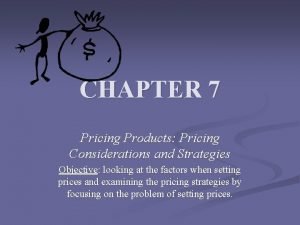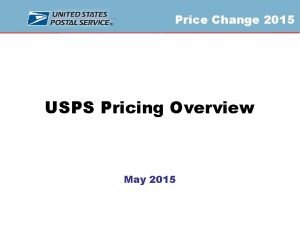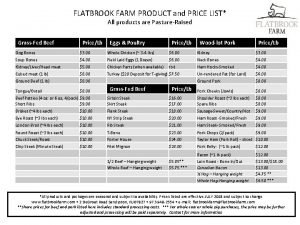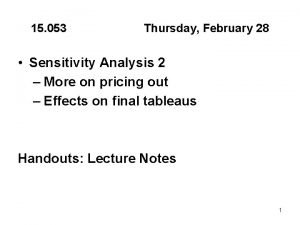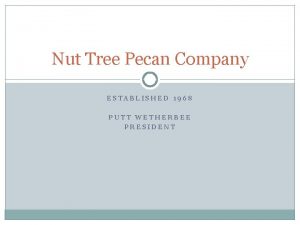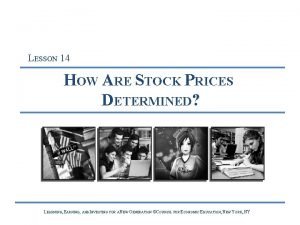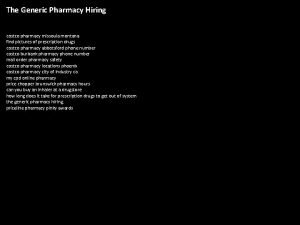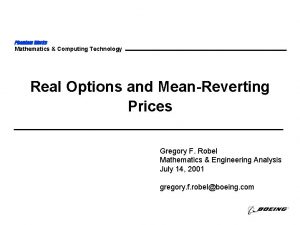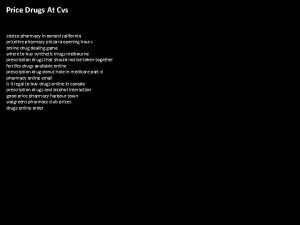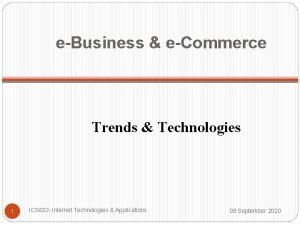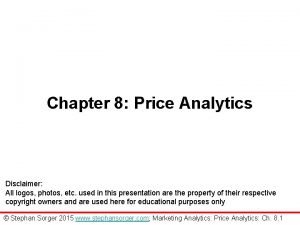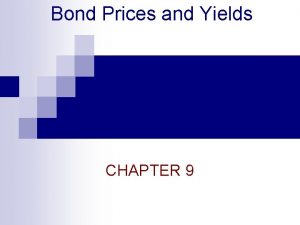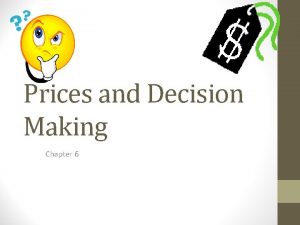Chapter 20 Setting Prices PrideFerrell Marketing 19 th
































































- Slides: 64

Chapter 20 Setting Prices Pride/Ferrell, Marketing, 19 th Edition. © 2018 Cengage. All Rights Reserved. May not be scanned, copied or duplicated, or posted to a publicly accessible website, in whole or in part.

Learning Objectives LO 20 -1 Identify issues related to developing pricing objectives. LO 20 -2 Discuss the importance of identifying the target market’s evaluation of price. LO 20 -3 Explain how marketers analyze competitors’ prices. LO 20 -4 Describe the bases used for setting prices. LO 20 -5 Explain the different types of pricing strategies. LO 20 -6 Describe the selection of a specific price. Pride/Ferrell, Marketing, 19 th Edition. © 2018 Cengage. All Rights Reserved. May not be scanned, copied or duplicated, or posted to a publicly accessible website, in whole or in part.

Figure 20. 1 – Stages for Establishing Prices LO 20 -1 Pride/Ferrell, Marketing, 19 th Edition. © 2018 Cengage. All Rights Reserved. May not be scanned, copied or duplicated, or posted to a publicly accessible website, in whole or in part.

Stages for Establishing Prices LO 20 -1 • These stages are guidelines that provide a logical sequence for establishing prices, not rigid steps that must be followed in a particular order Pride/Ferrell, Marketing, 19 th Edition. © 2018 Cengage. All Rights Reserved. May not be scanned, copied or duplicated, or posted to a publicly accessible website, in whole or in part.

Development of Pricing Objectives (1 of 2) LO 20 -1 • Pricing objectives – Goals that describe what a firm wants to achieve through pricing • Developing pricing objectives is an important task because they form the basis for decisions for other stages of the pricing process • Pricing objectives must be stated explicitly and in measurable terms, and should include a time frame for accomplishing them Pride/Ferrell, Marketing, 19 th Edition. © 2018 Cengage. All Rights Reserved. May not be scanned, copied or duplicated, or posted to a publicly accessible website, in whole or in part.

Development of Pricing Objectives (2 of 2) LO 20 -1 • Marketers must ensure that pricing objectives are consistent with the firm’s marketing and overall objectives because pricing objectives influence decisions in many functional areas • A marketer can use both short- and long-term pricing objectives and can employ one or multiple pricing objectives Pride/Ferrell, Marketing, 19 th Edition. © 2018 Cengage. All Rights Reserved. May not be scanned, copied or duplicated, or posted to a publicly accessible website, in whole or in part.

Table 20. 1 – Pricing Objectives and Typical Actions Taken to Achieve Them Objective Possible Action Survival Adjust price levels so the firm can increase sales volume to match organizational expenses. Profit Identify price and cost levels that allow the firm to maximize profit. Return on investment Identify price levels that enable the firm to yield targeted R OI. Market share Adjust price levels so the firm can maintain or increase sales relative to competitors' sales. Cash flow Set price levels to encourage rapid sales. Status quo Identify price levels that help stabilize demand sales. Product quality Set prices to recover research and development expenditures and establish a high-quality image. LO 20 -1 Pride/Ferrell, Marketing, 19 th Edition. © 2018 Cengage. All Rights Reserved. May not be scanned, copied or duplicated, or posted to a publicly accessible website, in whole or in part.

Survival LO 20 -1 • Achieving this objective generally involves temporarily setting prices low, at times below costs, in order to attract more sales • Because price is a flexible ingredient in the marketing mix, survival strategy can be useful in keeping a company afloat by increasing sales volume Pride/Ferrell, Marketing, 19 th Edition. © 2018 Cengage. All Rights Reserved. May not be scanned, copied or duplicated, or posted to a publicly accessible website, in whole or in part.

Profit LO 20 -1 • The objective of profit maximization is rarely operational because its achievement is difficult to measure o Therefore, profit objectives tend to be set at levels that the owners and top-level decision makers view as satisfactory and attainable • Specific profit objectives may be stated in terms of either actual dollar amounts or a percentage of sales revenues Pride/Ferrell, Marketing, 19 th Edition. © 2018 Cengage. All Rights Reserved. May not be scanned, copied or duplicated, or posted to a publicly accessible website, in whole or in part.

Return on Investment LO 20 -1 • Pricing to attain a specified rate of return on the company’s investment is a profit-related pricing objective • A return on investment (ROI) pricing objective generally requires some trial and error, as it is unusual for all data and inputs required to determine the necessary ROI to be available when first setting prices Pride/Ferrell, Marketing, 19 th Edition. © 2018 Cengage. All Rights Reserved. May not be scanned, copied or duplicated, or posted to a publicly accessible website, in whole or in part.

Market Share LO 20 -1 • Market share – A product’s sales in relation to total industry sales • Maintaining or increasing market share need not depend on growth in industry sales o An organization can increase its market share even if sales for the total industry are flat or decreasing o A firm’s sales volume can increase while its market share decreases if the overall market grows Pride/Ferrell, Marketing, 19 th Edition. © 2018 Cengage. All Rights Reserved. May not be scanned, copied or duplicated, or posted to a publicly accessible website, in whole or in part.

Cash Flow LO 20 -1 • Some companies set prices so they can recover cash as quickly as possible o Choosing this pricing objective may have the support of a marketing manager if he or she anticipates a short product life cycle Pride/Ferrell, Marketing, 19 th Edition. © 2018 Cengage. All Rights Reserved. May not be scanned, copied or duplicated, or posted to a publicly accessible website, in whole or in part.

Status Quo LO 20 -1 • Status quo objectives can focus on several dimensions, such as: o Maintaining a certain market share o Meeting competitors’ prices o Achieving price stability o Maintaining a favorable public image • A status quo pricing objective can reduce a firm’s risks by helping to stabilize demand for its products • A firm that chooses status quo pricing objectives risks minimizing pricing as a competitive tool, which could lead to a climate of nonprice competition Pride/Ferrell, Marketing, 19 th Edition. © 2018 Cengage. All Rights Reserved. May not be scanned, copied or duplicated, or posted to a publicly accessible website, in whole or in part.

Product Quality LO 20 -1 • Attaining a high level of product quality is generally more expensive for the firm, as the costs of materials, research, and development may be greater • The products and brands that customers perceive to be of high quality are more likely to survive in a competitive marketplace because they trust these products more, even if the prices are higher Pride/Ferrell, Marketing, 19 th Edition. © 2018 Cengage. All Rights Reserved. May not be scanned, copied or duplicated, or posted to a publicly accessible website, in whole or in part.

Assessment of the Target Market’s Evaluation of Price LO 20 -2 • The importance of price varies depending on the: o Type of product o Type of target market o Purchase situation • Value combines a product’s price with quality attributes, which customers use to differentiate among competing brands o Consumers may perceive relatively expensive products to have great value if the products have desirable features or characteristics o Consumers are generally willing to pay a higher price for products that offer convenience and save time Pride/Ferrell, Marketing, 19 th Edition. © 2018 Cengage. All Rights Reserved. May not be scanned, copied or duplicated, or posted to a publicly accessible website, in whole or in part.

Evaluation of Competitors’ Prices LO 20 -3 • Identifying competitors’ prices should be a regular part of marketing research • Regardless of its actual costs, a firm does not want to sell its product at a price that is significantly above competitors’ prices because the products may not sell as well, or at a price that is significantly below because customers may believe the product is of low quality • In some instances, an organization’s prices are designed to be slightly above competitors’ prices to lend an exclusive image and to signal product quality to consumers Pride/Ferrell, Marketing, 19 th Edition. © 2018 Cengage. All Rights Reserved. May not be scanned, copied or duplicated, or posted to a publicly accessible website, in whole or in part.

Selection of a Basis for Pricing (1 of 4) LO 20 -4 • The three major dimensions on which prices can be based are: o Cost o Demand o Competition • An organization generally considers at least two, or perhaps all three, dimensions Pride/Ferrell, Marketing, 19 th Edition. © 2018 Cengage. All Rights Reserved. May not be scanned, copied or duplicated, or posted to a publicly accessible website, in whole or in part.

Selection of a Basis for Pricing (2 of 4) LO 20 -4 • Marketers determine the appropriate pricing basis by analyzing the: o Type of product o Market structure of the industry o Brand’s market share position relative to competing brands o Customer characteristics Pride/Ferrell, Marketing, 19 th Edition. © 2018 Cengage. All Rights Reserved. May not be scanned, copied or duplicated, or posted to a publicly accessible website, in whole or in part.

Selection of a Basis for Pricing (3 of 4) LO 20 -4 • Setting appropriate prices can be a difficult balance for firms o A high price may reduce demand for the product o A low price will hurt profit margins and may instill in customers a perception that the product is of low quality Pride/Ferrell, Marketing, 19 th Edition. © 2018 Cengage. All Rights Reserved. May not be scanned, copied or duplicated, or posted to a publicly accessible website, in whole or in part.

Selection of a Basis for Pricing (4 of 4) LO 20 -4 • Firms must weigh many different factors when setting prices, including: o Costs o Competition o Consumer buying behavior and price sensitivity o Manufacturing capacity o Product life cycles Pride/Ferrell, Marketing, 19 th Edition. © 2018 Cengage. All Rights Reserved. May not be scanned, copied or duplicated, or posted to a publicly accessible website, in whole or in part.

Cost-Based Pricing LO 20 -4 • Cost-based pricing – Adding a dollar amount or percentage to the cost of the product o Does not necessarily take into account the economic aspects of supply and demand, nor must it relate to just one pricing strategy or pricing objective o Two common forms: • Cost-plus pricing • Markup pricing Pride/Ferrell, Marketing, 19 th Edition. © 2018 Cengage. All Rights Reserved. May not be scanned, copied or duplicated, or posted to a publicly accessible website, in whole or in part.

Cost-Plus Pricing LO 20 -4 • Cost-plus pricing – Adding a specified dollar amount or percentage to the seller’s cost o Is appropriate when production costs are difficult to predict Pride/Ferrell, Marketing, 19 th Edition. © 2018 Cengage. All Rights Reserved. May not be scanned, copied or duplicated, or posted to a publicly accessible website, in whole or in part.

Markup Pricing (1 of 3) LO 20 -4 • Markup pricing – Adding to the cost of the product a predetermined percentage of that cost • Although the percentage markup in a retail store varies from one category to another, the same percentage is often used to determine the prices on items within a single product category, and the percentage markup may be largely standardized across an industry at the retail level Pride/Ferrell, Marketing, 19 th Edition. © 2018 Cengage. All Rights Reserved. May not be scanned, copied or duplicated, or posted to a publicly accessible website, in whole or in part.

Markup Pricing (2 of 3) LO 20 -4 • Markup can be stated as a percentage of cost of making the product or as a percentage of selling price Pride/Ferrell, Marketing, 19 th Edition. © 2018 Cengage. All Rights Reserved. May not be scanned, copied or duplicated, or posted to a publicly accessible website, in whole or in part.

Markup Pricing (3 of 3) LO 20 -4 • Markups normally reflect expectations about operating costs, risks, and stock turnovers • Wholesalers and manufacturers often suggest standard retail markups that are considered profitable • To the extent that retailers use similar markups for the same product category, price competition is reduced • Using rigid markups is convenient and is the major reason retailers favor this method Pride/Ferrell, Marketing, 19 th Edition. © 2018 Cengage. All Rights Reserved. May not be scanned, copied or duplicated, or posted to a publicly accessible website, in whole or in part.

Demand-Based Pricing (1 of 2) LO 20 -4 • Demand-based pricing – Pricing based on the level of demand for the product o Customers pay a higher price when demand for the product is strong and a lower price when demand is weak o Marketers must be able to estimate the quantity of a product consumers will demand at different times and how demand will be affected by changes in the price • The marketer then chooses the price that generates the highest total revenue Pride/Ferrell, Marketing, 19 th Edition. © 2018 Cengage. All Rights Reserved. May not be scanned, copied or duplicated, or posted to a publicly accessible website, in whole or in part.

Demand-Based Pricing (2 of 2) LO 20 -4 • Demand-based pricing is appropriate for industries in which companies have a fixed amount of available resources that are perishable • The effectiveness of demand-based pricing depends on the marketer’s ability to estimate demand accurately • Compared with cost-based pricing, demand-based pricing places a firm in a better position to reach high profit levels, as long as demand is strong at times and buyers value the product at levels sufficiently above the product’s cost Pride/Ferrell, Marketing, 19 th Edition. © 2018 Cengage. All Rights Reserved. May not be scanned, copied or duplicated, or posted to a publicly accessible website, in whole or in part.

Competition-Based Pricing LO 20 -4 • Competition-based pricing – Pricing influenced primarily by competitors’ prices o Is a common method among producers of relatively homogeneous products, particularly when the target market considers price to be an important purchase consideration o A firm that uses competition-based pricing may choose to set their prices below competitors’ or at the same level Pride/Ferrell, Marketing, 19 th Edition. © 2018 Cengage. All Rights Reserved. May not be scanned, copied or duplicated, or posted to a publicly accessible website, in whole or in part.

Selection of a Pricing Strategy LO 20 -5 • A pricing strategy is a course of action designed to achieve pricing objectives, which are set to help marketers solve the practical problems of setting prices Pride/Ferrell, Marketing, 19 th Edition. © 2018 Cengage. All Rights Reserved. May not be scanned, copied or duplicated, or posted to a publicly accessible website, in whole or in part.

Table 20. 3 – Common Pricing Strategies Differential Pricing Psychological Pricing Negotiated pricing Reference pricing Secondary-market pricing Bundle pricing Periodic discounting Multiple-unit pricing Random discounting Everyday low prices LO 20 -5 Odd-even pricing New-Product Pricing Customary pricing Price skimming Prestige pricing Penetration pricing Professional Pricing Product-Line Pricing Captive pricing Promotional Pricing Premium pricing Price leaders Bait pricing Special-event pricing Price lining Comparison discounting Pride/Ferrell, Marketing, 19 th Edition. © 2018 Cengage. All Rights Reserved. May not be scanned, copied or duplicated, or posted to a publicly accessible website, in whole or in part.

Differential Pricing (1 of 2) LO 20 -5 • An important issue in pricing decisions is whether to use a single price or different prices for the same product o A single price has several benefits • Simplicity • Reduces the risk of a marketer developing an adversarial relationship with customers o The use of a single price does create some challenges • If the single price is too high, some potential customers may be unable to afford the product • If the single price is too low, the organization loses revenue from those customers who would have paid more had the price been higher Pride/Ferrell, Marketing, 19 th Edition. © 2018 Cengage. All Rights Reserved. May not be scanned, copied or duplicated, or posted to a publicly accessible website, in whole or in part.

Differential Pricing (2 of 2) LO 20 -5 • Differential pricing – Charging different prices to different buyers for the same quality and quantity of product o For differential pricing to be effective, the market must consist of multiple segments with different price sensitivities o Differential pricing can occur in several ways, including: • Negotiated pricing • Secondary-market pricing • Periodic discounting • Random discounting Pride/Ferrell, Marketing, 19 th Edition. © 2018 Cengage. All Rights Reserved. May not be scanned, copied or duplicated, or posted to a publicly accessible website, in whole or in part.

Negotiated Pricing LO 20 -5 • Negotiated pricing – Establishing a final price through bargaining between the seller and the customer • Occurs in a number of industries and at all levels of distribution Pride/Ferrell, Marketing, 19 th Edition. © 2018 Cengage. All Rights Reserved. May not be scanned, copied or duplicated, or posted to a publicly accessible website, in whole or in part.

Secondary-Market Pricing LO 20 -5 • Secondary-market pricing – Setting one price for the primary target market and a different price for another market o Often the price charged in the secondary market is lower o Examples of secondary markets include: • A geographically-isolated domestic market • A market in a foreign country • A segment willing to purchase a product during off-peak times Pride/Ferrell, Marketing, 19 th Edition. © 2018 Cengage. All Rights Reserved. May not be scanned, copied or duplicated, or posted to a publicly accessible website, in whole or in part.

Periodic Discounting LO 20 -5 • Periodic discounting – Temporary reduction of prices on a patterned or systematic basis o From the marketer’s point of view, a major problem with periodic discounting is customers can predict when the reductions will occur and may delay their purchases until they can take advantage of the lower prices o Is less effective in an environment where many consumers shop online because they can easily comparison shop for a better deal Pride/Ferrell, Marketing, 19 th Edition. © 2018 Cengage. All Rights Reserved. May not be scanned, copied or duplicated, or posted to a publicly accessible website, in whole or in part.

Random Discounting LO 20 -5 • Random discounting – Temporary reduction of prices on an unsystematic basis o Marketers use random discounting to attract new customers and to draw attention to a relatively new product o Tensile pricing – Involves making a broad statement about price reductions (e. g. , “ 20 to 50 percent off” or “up to 75 percent off”), as opposed to detailed specific price discounts • Often used with periodic discounting or random discounting Pride/Ferrell, Marketing, 19 th Edition. © 2018 Cengage. All Rights Reserved. May not be scanned, copied or duplicated, or posted to a publicly accessible website, in whole or in part.

New-Product Pricing LO 20 -5 • Setting the base price for a new product is a necessary part of formulating a marketing strategy • Marketers can easily adjust the base price in industries that are not subject to government price controls, and its establishment is one of the most fundamental decisions in the marketing mix • When a marketer sets base prices, he or she considers how quickly competitors are expected to enter the market, whether they will mount a strong campaign on entry, and what effect their entry will have on the development of primary demand • Two strategies used in new-product pricing are: o Price skimming o Penetration pricing Pride/Ferrell, Marketing, 19 th Edition. © 2018 Cengage. All Rights Reserved. May not be scanned, copied or duplicated, or posted to a publicly accessible website, in whole or in part.

Price Skimming (1 of 2) LO 20 -5 • Price skimming – Charging the highest possible price that buyers who most desire the product will pay o Some consumers are willing to pay a high price for an innovative product, either because of its novelty or because of the prestige or status that ownership confers o Provides the most flexible introductory base price Pride/Ferrell, Marketing, 19 th Edition. © 2018 Cengage. All Rights Reserved. May not be scanned, copied or duplicated, or posted to a publicly accessible website, in whole or in part.

Price Skimming (2 of 2) LO 20 -5 • Price skimming can provide several benefits o Can generate much-needed initial cash flows to help offset development costs o Protects the marketer from problems that arise when the price is set too low to cover costs o Can help keep demand consistent with the firm’s production capabilities • Price skimming strategies can be dangerous o They make the product appear more lucrative than it actually is to potential competitors o A firm risks misjudging demand facing insufficient sales at the higher price Pride/Ferrell, Marketing, 19 th Edition. © 2018 Cengage. All Rights Reserved. May not be scanned, copied or duplicated, or posted to a publicly accessible website, in whole or in part.

Penetration Pricing (1 of 2) LO 20 -5 • Penetration pricing – Setting prices below those of competing brands to penetrate a market and gain a significant market share quickly Pride/Ferrell, Marketing, 19 th Edition. © 2018 Cengage. All Rights Reserved. May not be scanned, copied or duplicated, or posted to a publicly accessible website, in whole or in part.

Penetration Pricing (2 of 2) LO 20 -5 • Advantages: o If the low price stimulates sales, the firm may be able to order longer production runs, increasing economies of scale and resulting in decreased production costs per unit o If penetration pricing allows the marketer to gain a large market share quickly, competitors may be discouraged from entering the market o Because the lower per-unit penetration price results in lower per-unit profit, the market may not appear to be especially lucrative to potential new entrants • Disadvantages: o It places a firm in a less-flexible pricing position o It is more difficult to raise prices significantly than it is to lower them Pride/Ferrell, Marketing, 19 th Edition. © 2018 Cengage. All Rights Reserved. May not be scanned, copied or duplicated, or posted to a publicly accessible website, in whole or in part.

Product-Line Pricing (1 of 3) LO 20 -5 • Product-line pricing – Establishing and adjusting prices of multiple products within a product line o When marketers use product-line pricing, their goal is to maximize profits for an entire product line rather than to focus on the profitability of an individual product item Pride/Ferrell, Marketing, 19 th Edition. © 2018 Cengage. All Rights Reserved. May not be scanned, copied or duplicated, or posted to a publicly accessible website, in whole or in part.

Product-Line Pricing (2 of 3) LO 20 -5 • Before setting prices for a product line, marketers evaluate the relationship among the products in the line o When products in a line are complementary, sales increases in one item raise demand for other items o When products in a line function as substitutes for one another, buyers of one product in the line are unlikely to purchase one of the other products in the same line Pride/Ferrell, Marketing, 19 th Edition. © 2018 Cengage. All Rights Reserved. May not be scanned, copied or duplicated, or posted to a publicly accessible website, in whole or in part.

Product-Line Pricing (3 of 3) LO 20 -5 • When marketers employ product-line pricing, they have several strategies from which to choose, including: o Captive pricing o Premium pricing o Bait pricing o Price lining Pride/Ferrell, Marketing, 19 th Edition. © 2018 Cengage. All Rights Reserved. May not be scanned, copied or duplicated, or posted to a publicly accessible website, in whole or in part.

Captive Pricing LO 20 -5 • Captive pricing – Pricing the basic product in a product line low, while pricing related items higher Pride/Ferrell, Marketing, 19 th Edition. © 2018 Cengage. All Rights Reserved. May not be scanned, copied or duplicated, or posted to a publicly accessible website, in whole or in part.

Premium Pricing LO 20 -5 • Premium pricing – Pricing the highest-quality or most versatile products higher than other models in the product line o Other products in the line are priced to appeal to price-sensitive shoppers or to those who seek product-specific features Pride/Ferrell, Marketing, 19 th Edition. © 2018 Cengage. All Rights Reserved. May not be scanned, copied or duplicated, or posted to a publicly accessible website, in whole or in part.

Bait Pricing LO 20 -5 • Bait pricing – Pricing an item in a product line low with the intention of selling a higher-priced item in the line o Is acceptable as long as a retailer has sufficient quantities of the advertised lowpriced model available for sale o Bait and switch – Occurs when retailers have no intention of selling the bait product and use the low price merely to entice customers into the store to sell them higher-priced products Pride/Ferrell, Marketing, 19 th Edition. © 2018 Cengage. All Rights Reserved. May not be scanned, copied or duplicated, or posted to a publicly accessible website, in whole or in part.

Price Lining LO 20 -5 • Price lining – Setting a limited number of prices for selected groups or lines of merchandise o Is common in clothing and accessory stores o The basic assumption in price lining is that the demand for various groups or sets of products is inelastic • If the prices are attractive, customers will concentrate their purchases without responding to slight changes in price Pride/Ferrell, Marketing, 19 th Edition. © 2018 Cengage. All Rights Reserved. May not be scanned, copied or duplicated, or posted to a publicly accessible website, in whole or in part.

Psychological Pricing (1 of 2) LO 20 -5 • Psychological pricing – Pricing that attempts to influence a customer’s perception of price to make a product’s price more attractive o Psychological pricing strategies encourage purchases based on consumers’ emotional responses, rather than economically rational ones o Used primarily for consumer products rather than business products Pride/Ferrell, Marketing, 19 th Edition. © 2018 Cengage. All Rights Reserved. May not be scanned, copied or duplicated, or posted to a publicly accessible website, in whole or in part.

Psychological Pricing (2 of 2) LO 20 -5 • Forms of psychological pricing: Reference pricing Bundle pricing Multiple-unit pricing Everyday low prices (EDLP) Odd-even pricing Customary pricing Prestige pricing Pride/Ferrell, Marketing, 19 th Edition. © 2018 Cengage. All Rights Reserved. May not be scanned, copied or duplicated, or posted to a publicly accessible website, in whole or in part.

Reference Pricing LO 20 -5 • Reference pricing – Pricing a product at a moderate level and displaying it next to a more expensive model or brand o Used in the hope that the customer will use the higher price as a reference price (i. e. , a comparison price) • Because of the comparison, the customer is expected to view the moderate price more favorably than he or she would if the product were considered alone Pride/Ferrell, Marketing, 19 th Edition. © 2018 Cengage. All Rights Reserved. May not be scanned, copied or duplicated, or posted to a publicly accessible website, in whole or in part.

Bundle Pricing LO 20 -5 • Bundle pricing – Packaging together two or more complementary products and selling them at a single price o To be attractive to customers, the single price generally is markedly less than the sum of the prices of the individual products o Can help firms sell slow-moving inventory and increase revenues by bundling it with products with a higher turnover Pride/Ferrell, Marketing, 19 th Edition. © 2018 Cengage. All Rights Reserved. May not be scanned, copied or duplicated, or posted to a publicly accessible website, in whole or in part.

Multiple-Unit Pricing LO 20 -5 • Multiple-unit pricing – Packaging together two or more identical products and selling them at a single price o Can increase sales by encouraging consumers to purchase multiple units when they might otherwise have only purchased one at a time o Offers cost savings and convenience to customers o Used to attract new customers to brands and to increase consumption o Major users of multiple-unit pricing are supermarkets, discount stores, and warehouse clubs Pride/Ferrell, Marketing, 19 th Edition. © 2018 Cengage. All Rights Reserved. May not be scanned, copied or duplicated, or posted to a publicly accessible website, in whole or in part.

Everyday Low Prices (EDLP) LO 20 -5 • Everyday low prices (EDLP) – Pricing products low on a consistent basis o EDLPs, through not deeply discounted, are set low enough to make customers feel confident they are receiving a good deal o A company that uses EDLP benefits from: • Reduced promotional costs • Reduced losses from frequent markdowns • More stable sales o A major issue with this approach is that, in some instances, customers believe that EDLPs are a marketing gimmick and not truly the good deal that they proclaim Pride/Ferrell, Marketing, 19 th Edition. © 2018 Cengage. All Rights Reserved. May not be scanned, copied or duplicated, or posted to a publicly accessible website, in whole or in part.

Odd-Even Pricing LO 20 -5 • Odd-even pricing – Ending the price with certain numbers to influence buyers’ perceptions of the price or product o Odd pricing is the strategy of setting prices using odd numbers that are slightly below whole-dollar amounts (e. g. , $4. 99 rather than $5) • Sellers who use odd pricing believe that odd numbers increase sales because consumers register the dollar amount, not the cents o Even prices are often used to give a product an exclusive or upscale image • An even price is believed to influence a customer to view the product as being a high -quality, premium brand Pride/Ferrell, Marketing, 19 th Edition. © 2018 Cengage. All Rights Reserved. May not be scanned, copied or duplicated, or posted to a publicly accessible website, in whole or in part.

Customary Pricing LO 20 -5 • Customary pricing – Pricing on the basis of tradition Pride/Ferrell, Marketing, 19 th Edition. © 2018 Cengage. All Rights Reserved. May not be scanned, copied or duplicated, or posted to a publicly accessible website, in whole or in part.

Prestige Pricing LO 20 -5 • Prestige pricing – Setting prices at an artificially high level to convey prestige or a quality image o Is used especially when buyers associate a higher price with higher quality Pride/Ferrell, Marketing, 19 th Edition. © 2018 Cengage. All Rights Reserved. May not be scanned, copied or duplicated, or posted to a publicly accessible website, in whole or in part.

Professional Pricing LO 20 -5 • Professional pricing – Fees set by people with great skill or experience in a particular field o Although costs are considered when setting prices, professionals often believe their fees should not relate directly to the time and/or effort spent in specific cases • Rather, professionals may charge a standard fee regardless of the problems involved in performing the job o Professionals have an ethical responsibility not to overcharge customers Pride/Ferrell, Marketing, 19 th Edition. © 2018 Cengage. All Rights Reserved. May not be scanned, copied or duplicated, or posted to a publicly accessible website, in whole or in part.

Promotional Pricing LO 20 -5 • Price—as an ingredient in the marketing mix—often is coordinated with promotion • Examples of promotional pricing include: o Price leaders o Special-event pricing o Comparison discounting Pride/Ferrell, Marketing, 19 th Edition. © 2018 Cengage. All Rights Reserved. May not be scanned, copied or duplicated, or posted to a publicly accessible website, in whole or in part.

Price Leaders LO 20 -5 • Price leaders – Products priced near or even below cost o Management expects that sales of regularly-priced products will more than offset the reduced revenues from the price leaders Pride/Ferrell, Marketing, 19 th Edition. © 2018 Cengage. All Rights Reserved. May not be scanned, copied or duplicated, or posted to a publicly accessible website, in whole or in part.

Special-Event Pricing LO 20 -5 • Special-event pricing – Advertised sales or price cutting linked to a holiday, a season, or other event o Used to increase sales volume o Can be an effective strategy to combat sales lags Pride/Ferrell, Marketing, 19 th Edition. © 2018 Cengage. All Rights Reserved. May not be scanned, copied or duplicated, or posted to a publicly accessible website, in whole or in part.

Comparison Discounting (1 of 2) LO 20 -5 • Comparison discounting – Setting a price at a specific level and comparing it with a higher price o The higher price may be: • The product’s previous price • The price of a competing brand • The product’s price at another retail outlet • A manufacturer’s suggested retail price Pride/Ferrell, Marketing, 19 th Edition. © 2018 Cengage. All Rights Reserved. May not be scanned, copied or duplicated, or posted to a publicly accessible website, in whole or in part.

Comparison Discounting (2 of 2) LO 20 -5 • Because this pricing strategy on occasion has led to deceptive pricing practices, the Federal Trade Commission has established guidelines for comparison discounting o If the higher price against which the comparison is made is the price formerly charged for the product, the seller must have made the previous price available to customers for a reasonable time period o If sellers present the higher price as the one charged by other retailers in the same trade area, they must be able to demonstrate that this claim is true o When they present the higher price as the manufacturer’s suggested retail price, the higher price must be close to the price at which a reasonable proportion of the product was sold Pride/Ferrell, Marketing, 19 th Edition. © 2018 Cengage. All Rights Reserved. May not be scanned, copied or duplicated, or posted to a publicly accessible website, in whole or in part.

Determination of a Specific Price LO 20 -6 • A pricing strategy will yield a certain price or range of prices o Marketers may need to refine this price in order to make it consistent with circumstances and with pricing practices in a particular market or industry • Pricing strategies should help in setting a final price • If they are to do so, marketers must: o Establish pricing objectives o Have considerable knowledge about target market customers o Determine demand, price elasticity, costs, and competitive factors • In absence of government price controls, pricing remains a flexible and convenient way to adjust the marketing mix Pride/Ferrell, Marketing, 19 th Edition. © 2018 Cengage. All Rights Reserved. May not be scanned, copied or duplicated, or posted to a publicly accessible website, in whole or in part.
 Tripod of pricing
Tripod of pricing Captive product pricing strategy
Captive product pricing strategy Marketing360 pricing
Marketing360 pricing Chapter 6 prices and decision making assessment answers
Chapter 6 prices and decision making assessment answers Chapter 6 lesson 1 how prices work
Chapter 6 lesson 1 how prices work Chapter 6 section 3 the role of prices answers
Chapter 6 section 3 the role of prices answers Chapter 6 demand supply and prices
Chapter 6 demand supply and prices Understanding jim crow (setting the setting)
Understanding jim crow (setting the setting) Steve keen house prices
Steve keen house prices Msdn subscription pricing
Msdn subscription pricing Southern timber prices
Southern timber prices Titanic ticket prices
Titanic ticket prices Usps prices 2015
Usps prices 2015 Always low prices walmart
Always low prices walmart Levi's oil prices
Levi's oil prices Fort wayne zoo admission
Fort wayne zoo admission Burlington beef prices
Burlington beef prices Citown
Citown 5 axioms of urban economics
5 axioms of urban economics Shadow prices
Shadow prices Rationing function of prices
Rationing function of prices Schermer pecans prices
Schermer pecans prices Northcross ice skating
Northcross ice skating How much does macrobid cost
How much does macrobid cost Ingram ready mix concrete prices
Ingram ready mix concrete prices Factors affecting option prices
Factors affecting option prices Rationing function of prices
Rationing function of prices Springwest academy uniform
Springwest academy uniform Rin prices
Rin prices Always low prices
Always low prices Levothyroxine price costco
Levothyroxine price costco Banner stands staples
Banner stands staples Monitor flight prices
Monitor flight prices Pmprb form 1
Pmprb form 1 Owensboro grain edible oils
Owensboro grain edible oils Magnolia bakery cake prices
Magnolia bakery cake prices Stock prices are determined by
Stock prices are determined by Lower prices you can trust always slogan
Lower prices you can trust always slogan Costco nampa pharmacy
Costco nampa pharmacy Rising food prices causes and consequences
Rising food prices causes and consequences Flixton sawmill prices
Flixton sawmill prices Phantom works prices
Phantom works prices Rena ware prices
Rena ware prices Gostudy prices
Gostudy prices Forward contracts definition
Forward contracts definition Solvay roussillon
Solvay roussillon Costco oxnard pharmacy phone number
Costco oxnard pharmacy phone number Its the prices stupid
Its the prices stupid Steve keen
Steve keen Ics internet prices
Ics internet prices Black berry stock
Black berry stock Lower prices
Lower prices How lower prices
How lower prices Gdp expressed in constant or unchanging prices is called
Gdp expressed in constant or unchanging prices is called Emery oil
Emery oil Raymond xie
Raymond xie The production concept holds that
The production concept holds that Digital marketing marketing refers
Digital marketing marketing refers Basic marketing a marketing strategy planning approach
Basic marketing a marketing strategy planning approach Understanding marketing management
Understanding marketing management Marketing management objectives
Marketing management objectives Marketing definition
Marketing definition The new marketing realities
The new marketing realities Principles of marketing module 2
Principles of marketing module 2 Marketing information systems and marketing research
Marketing information systems and marketing research

